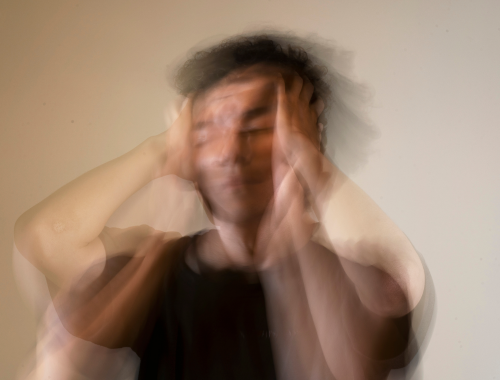Difference Between Somatic and Cognitive Anxiety
Two separate forms of anxiety, somatic anxiety (somatization, is the physical manifestation of anxiety) and cognitive anxiety (the mental manifestation of anxiety), each take different forms. It can be easier to identify and handle anxiety when you are aware of its differences.

Somatic anxiety
When anxiety sensations appear in the physical body, it is termed as somatic anxiety or somatization. Somatic means a body-related concept.
Somatic anxiety is widespread. All bodily systems are impacted by anxiety (tension), including the following:
- the digestive system
- system of muscles and skeleton
- breathing system
- circulatory system
- reproductive system, neurological system, and endocrine system
In addition to complicating daily life, anxiety and stress can cause or exacerbate

Cognitive anxiety
Thoughts, anxieties, and perceptions that can change or intensify during an anxious episode are signs of a cognitive anxiety disorder. The thoughts frequently focus on potential hazards, dangers, or unfavorable results. Concentration problems, indecision, and a generalized sense of dread or fear can all be symptoms of cognitive anxiety.
Difference between somatic anxiety and cognitive anxiety
Definition
Somatic anxiety
Somatic anxiety, also termed as physical anxiety, is the physical expression of anxiety. In the field of sports psychology, researchers study these different aspects of anxiety, particularly how anxiety symptoms can affect athletic performance. Symptoms commonly associated with somatic anxiety and other mental disorders include pain in abdomen, indigestion, pain in the chest, tiredness, dizziness, sleeping problems, and headaches. These symptoms may occur individually or in combination.
Cognitive anxiety
Cognitive anxiety which refers to the mental aspects of worry and the specific thought patterns that occur during anxiety. It includes the worries, anxieties, and ideas that an individual has while they are feeling anxious. Concentration problems, indecision, and a generalized sense of dread or fear can all be symptoms of cognitive anxiety.
Symptoms
Somatic anxiety
- Abdominal spasms
- Dizziness
- Stunned feelings
- Sweating
- Feeling of nausea
- Negative self-talk
- Trouble with balance
- Difficulties in breathing
- Hot and cold flushes
- Tachycardia
- Catastrophic thinking
Cognitive anxiety
- Poor concentration
- Suicidal thoughts
- Confusion
- Rapid heart rate
- Muscle tension
- Worry
- Rumination
Treatment
Somatic anxiety
- Relaxation techniques and mindfulness
- Antidepressant medication
- Avoid alcohol and recreational drugs
- Practice stress management and relaxation techniques
Cognitive anxiety
- Cognitive-behavioral therapy (CBT) that reduce stress and address depression and other mental health disorders
- Make sure to sleep well
- Eat healthy foods
Summary
The points of difference between somatic anxiety and cognitive anxiety have been summarized as below:

FAQ:
What is somatic and cognitive anxiety?
Somatic anxiety refers to the bodily manifestations and unease that come with anxiety. When the body’s fight-or-flight response is activated due to a perceived danger or stressor, it leads to physiological alterations that are represented by somatic anxiety, which essentially represents the physical aspect of anxiety.
Conversely, cognitive anxiety focuses on the psychological and emotional aspects of anxiety. It encompasses the worries, apprehensions, and cognitive processes that contribute to anxiety and uneasiness.
What is an example of somatic anxiety?
In response to anxiety, your fight-or-flight response kicks in, releasing hormones that produce tension and pain in your body. Somatic anxiety manifests as headaches, tense shoulders, and upset stomachs.
What is the relationship between cognitive and somatic anxiety and performance?
Performance and physical and cognitive anxiety have a complicated interaction that varies from person to person. Two aspects of anxiety, cognitive and somatic, can affect how people perform on a variety of tasks, especially in high-stress or performance-based settings.
In conclusion, there is a complex link between physical and cognitive anxiety and performance, with both positive and negative consequences depending on the individual and the level of anxiety. Anxiety management methods including mindfulness, relaxation, and cognitive-behavioral techniques can help people perform better in a variety of contexts.
What is the difference between physical and cognitive anxiety?
The physical symptoms and sensations that go along with anxiety are referred to as physical anxiety. These include a racing heartbeat (Tachycardia), trembling, sweating, tight muscles, nausea (urge to vomit), dizziness, and shortness of breath. Because they prime the body to react to a perceived threat, these symptoms are frequently referred to as the “fight or flight” (an automatic physiological reaction to an event that is perceived as stressful) reaction. The mental and emotional components of anxiety are termed as cognitive anxiety (the mental manifestation of anxiety), on the other hand. It involves the ideas, concerns, and perceptions that an anxious episode may skew or amplify. These ideas frequently revolve around hazards, dangers, or undesirable results.
What are cognitive anxiety examples?
Some examples of cognitive anxiety:
- Worrying about the future
- Catastrophizing
- Overthinking and rumination
- Self-doubt and low self-esteem
- Perfectionism
- Social anxiety thoughts
- Obsessive thoughts and compulsions
- Health-related anxiety
- Performance anxiety
- Generalized anxiety
What is the meaning of cognitive anxiety?
Thoughts, anxieties, and perceptions that can change or intensify during an anxious episode are signs of a cognitive anxiety disorder. The thoughts frequently focus on potential hazards, dangers, or unfavorable results.
- Difference Between Global Warming and Greenhouse Effect - May 18, 2024
- Difference Between Vaccination and Immunization - March 3, 2024
- Difference Between Selective Mutism and Autism - February 25, 2024
Search DifferenceBetween.net :
Leave a Response
References :
[0]Eysenck, M. W. (2013). Anxiety: The cognitive perspective. Psychology Press.
[1]Eysenck, M. W., MacLeod, C., & Mathews, A. (1987). Cognitive functioning and anxiety. Psychological research, 49(2-3), 189-195.
[2]Krane, V., & Williams, J. (1987). Performance and somatic anxiety, cognitive anxiety, and confidence changes prior to competition. Journal of Sport Behavior, 10(1), 47.
[3]Steptoe, A., & Kearsley, N. (1990). Cognitive and somatic anxiety. Behaviour Research and Therapy, 28(1), 75-81.
[4]Image credit: https://www.canva.com/photos/MAFG1Gjs5GY-blurry-portrait-of-a-man-in-black/
[5]Image credit: https://www.canva.com/photos/MAFhBf5l3WY-asian-student-woman-have-anxiety-because-of-exams-female-prepar/
